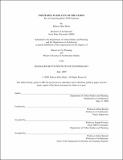The people in the city of the nation : re-viewing Islamabad's fifth function
Author(s)
Mohr, Robert Allen
DownloadFull printable version (44.35Mb)
Alternative title
Re-viewing Islamabad's fifth function
Other Contributors
Massachusetts Institute of Technology. Dept. of Architecture.
Advisor
Julian Beinart.
Terms of use
Metadata
Show full item recordAbstract
This thesis is about Islamabad's center. Islamabad is a city built from scratch. It was the "dream" of Ayub Khan-Pakistan's gregarious and globe-trotting general-cum-president-and the product of its chief master planner, Constantinos Doxiadis-the gregarious and globe-trotting architect-cum-global development expert. Endowed with a propensity for large-scale planning, both operated with a hubris-laden confidence in developing rational solutions to urban and national dilemmas, technocratic strategies employed as a means to realize grand visions. In this way, Islamabad was conceived by both as part of something much larger-Ayub's symbol of a freshly unified nation, steeped in nationalist fervor and draped with the dreams of progress, development and national unity, and Doxiadis's far-reaching vision of "Ecumenopolis", a planetary-scale entity of the far-distant future. Rationality and dreams form the structural and symbolic basis upon which Islamabad and its core were conceived and constructed; yet its envelopment in the dialectic of rationality and dreams, of practice and theory, has prevented Islamabad from developing its own cohesion independent of these larger visions. Functionally deficient and overly symbolic, what exists in Islamabad's central area today is not realized dreams but what emerged in between them. This thesis uncovers the story of how Islamabad's central axis and its terminus-the major buildings of Pakistan's Capital Complex-came to be what they are today. (cont.) This thesis is not solely concerned with the forensic or analytical, however. Nor does it look at Islamabad in a vacuum. Rather, I am interested in Islamabad as the contemporary capital of the nation-state of Pakistan-a state where the dream of an "Islamic Democracy" is still being sought after. It is the intention of this thesis to re-consider the physical manifestation of the national center of power and its environs and re-frame its monuments in a more complex light, acknowledging that the very question of the Pakistani "public" is entangled in that space.
Description
Thesis (M.C.P.)--Massachusetts Institute of Technology, Dept. of Urban Studies and Planning; and, (S.M.)--Massachusetts Institute of Technology, Dept. of Architecture, 2009. This electronic version was submitted by the student author. The certified thesis is available in the Institute Archives and Special Collections. Includes bibliographical references (p. 115-119).
Date issued
2009Department
Massachusetts Institute of Technology. Department of Architecture; Massachusetts Institute of Technology. Department of Urban Studies and PlanningPublisher
Massachusetts Institute of Technology
Keywords
Urban Studies and Planning., Architecture.